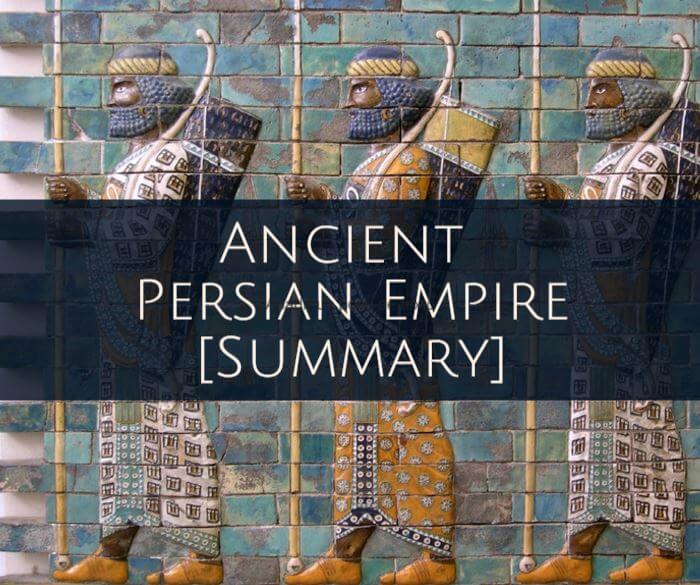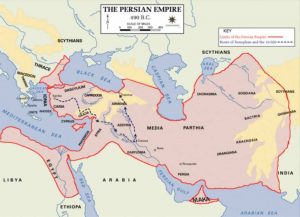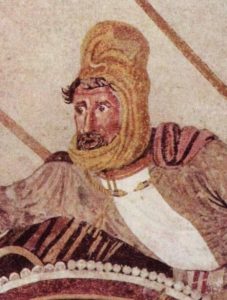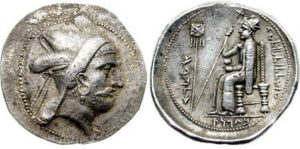The Ancient Persian Empire was a civilization of Indo-European origin of the Indo-Iranian branch that ended up merging with the people that they conquered in the Achaemenid period. It originated as a group of nomadic tribes whose original location was north of the Iranian plateau. Around 1400 BC, some of these tribes, ancestors of the historical Persians, moved to the south of Iran. Iran is a plateau of Asia, neighboring Mesopotamia, who witnessed important historical events. This plateau occupies 2,000,000 square kilometers. The central part of the plateau is a desert area, surrounded by high mountains. The fertile lands, suitable for cultivation and livestock, are found on the slopes and valleys of these mountains. At present, the region is occupied by the States of Iran, Afghanistan, and Pakistan, but in ancient times it was the place chosen by two peoples to settle and develop their civilization: the Medes and the Persians.

History of The Ancient Persian Empire
Contents
The First Empire
In the second millennium, around 1500, the Indo-European Persians from the other side of the Caucasus occupied the western regions of Iran. Other groups penetrated Asia Minor and other branches came to India. Those who remained in the Iranian plateau were called Medes and Persians, the Medes occupied the territories to the North of the plateau and the Persians, occupied the lands to the south. The situation in the area was as follows:
- Current Iran and West Turkey: The Medes
- In Mesopotamia, Syria, and Palestine: The Neo-Babylonians
- In North Africa: Egyptians trying to spread to Palestine and Syria
- In Turkey: Different states of Greek influence.
The Assyrians constantly launched campaigns against neighboring villages, robbing, killing and deporting the populations or their ruling classes. This caused great human and economic deterioration throughout the area, including Assyria, which became depopulated as a result of large casualties in the continuous wars. Assyria began to weaken, its enemies united in a great coalition, defeated it and by the year 610 BC, the Assyrians had been totally subdued.
The Persian Expansion

In the eighth century BC, the Medes possessed a kingdom with an organized army, which dominated the Iranian and Persian peoples, forcing them to pay hefty taxes. This caused the unrest of the Persian population, until in 550 BC. Cyrus the great, of the Aquemenidas dynasty, led a rebellion against the Medes, being victorious and collecting on its dominions and influence in all of the tribes that inhabited the Plateau of Iran.
The Persian Empire began to form from the governing body. Ciro the Great led the Persians to expansion, conquering great regions and thereby resolving the increase in population and assisting in their dietary needs since the region of Iran did not supply its empire completely.
Cyrus the Great, founder of the Persian Empire, after defeating the Medes and all the peoples of the Iranian Plateau, set out to conquer the kingdoms of Lydia and the Greek cities of Asia Minor. In 539 BC, the Persians conquered the region of Mesopotamia. Cyrus the Great ordered the return of the Jews to the region of Palestine, after releasing them from their captivity by annexing the region of Babylon, as well as all Mesopotamia, Phoenicia, and Palestine.
Cyrus II the Great died in combat in the year 529 BC and was succeeded by his son, Cambyses II, who conquered Egypt with a great army in 525 BC in the battle of Pelusa. Upon his return to Persia, Cambyses was killed in an internal revolt. He was succeeded by his son Darius I the Great.
The Fall of the Persian Empire

The great ambition of the Persian emperor, Darius I, was the conquest of Greece. Thus begins the so-called The Medica Wars, which would involve the Persians and the Greeks. The First Medica War would result in the defeat of the Persians in the year 490 BC. In the battle of Marathon, Greek cities led by Athens, with a better army that was more orderly and disciplined, obtained victory over the forces of the Persian Empire, this put an end to the ambitions of Darius I in continental Greece, although it expanded the territory of his empire in the islands of the Aegean Sea.
After the death of Darius I, his son Xerxes I inherited not only the throne but also his desire to subdue the Greeks. This military campaign would initiate the Second Medica War, where one of the most epic battles that took place was the battle of Thermopylae. It was named after the passage of Thermopylae, the location of the battle.
Xerxes I assembled an army and an immense navy to conquer all of Greece. The Greeks, aware of the plans of Xerxes I, managed to recruit an army of men among the Greek polis. Led by Sparta, Athenian general Themistocles proposed that the Greek allies cut off the path and the advance of the Persian army in the Passage of Thermopylae. At the same time, they blocked the advance of the Persians in the Straits of Artemis.
Enormously outnumbered, the Greeks halted the Persian advance for seven days in all, before they were overtaken from the rear. During two full days of battle, a small force commanded by king Leonidas I of Sparta blocked the only way that the immense Persian army could use to access Greece.
After the second day of battle, a local resident named Ephialtes betrayed the Greeks by showing the invaders a small path they could use to access the rear of the Greek lines. Knowing that his lines were to be surmounted, Leonidas dismissed most of the Greek army, remaining to protect their retreat along with 300 Spartans, 700 Thespians, 400 Thebans and possibly a few hundred more soldiers, most of whom died in battle.
Despite this victory by the Persians, the Second Medica War would also end in victory for the Greeks led by the Hellenic cities of Athens and Sparta. This meant that the Persian emperors had enormous difficulties in maintaining control of their cities. Revolts, political intrigues, economic problems, etc., were determining factors that contributed to the decline of the Empire, which was to be conquered in 330 BC by the army of Alexander the Great.
Culture of the Ancient Persian Empire
Persian Economy – Summary

The Persian economy was based on agriculture, grazing, mining, and of course commerce, which kept it in contact with other cultures, the creation of coins, daric, minted in gold, further stimulated, domestic trade as well as outside.
With the formation of the empire, commerce became a much more important activity, giving rise to a new social class of wealthy merchants. The geographical location of the Iranian plateau caused large tracts of commercial caravans to pass through their territories, linked mainly to India and China and ending in the Mediterranean Sea. The trade prompted the luxury fabric industry, jewelry, mosaics and tapestries or carpets of great beauty.
Social Organization of the Persians – Summary
The social classes were the backbone of Persian society, at the top of the social ladder was the King and his family. Then came the royal family, where the aristocracy (priests, nobles and great merchants) was located. The middle and popular classes (merchants, artisans, and soldiers) followed.
The last ladder was for the peasants, who, although considered free, formed the social base of the pyramid. Much of the weight of the other social classes fell in this class. They were the ones who paid the most taxes. The peasants lived miserably, were exploited, forced to deliver almost everything they produced on the land and served the community by collaborating in the construction of palaces and public works such as irrigation canals, roads, bridges, etc. Slaves and prisoners of war were not considered citizens and were assigned all the heaviest work in the construction of public works and palaces.
Religion – Summary
The main religion of Persia was Zoroastrianism, a dualistic religion with belief in two gods. The god Ormuz, who represents the good and the god Ahriman, who represents evil. According to Zoroastrianism, on judgment day, the god of good, Ormuz, will overcome and throw the god of evil, Ahriman, into the eternal abyss. On that day the dead will rise and the final judgment will take place. The righteous will go to heaven and the unrighteous, hell. The book containing the teachings of Zoroaster is called Zend-Avesta, it is the sacred book of the Persians.
